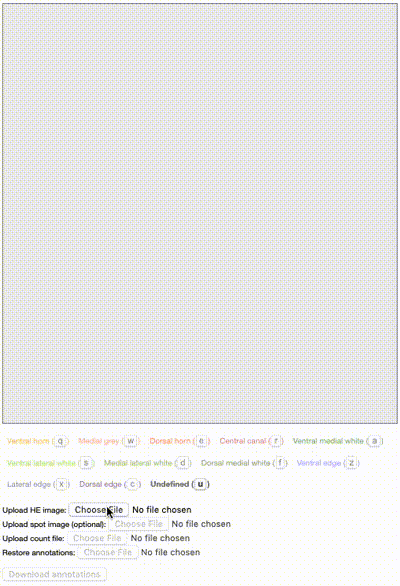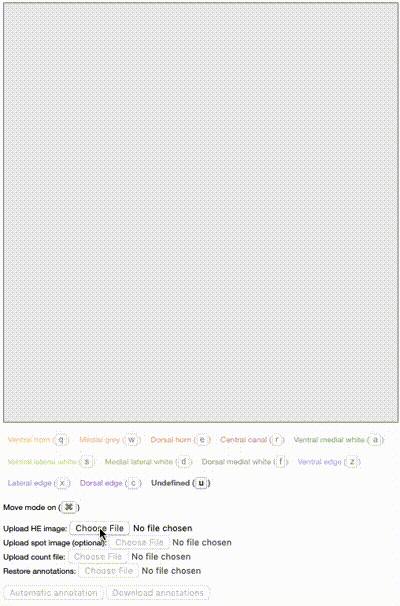A simple js tool to annotate Spatial Transcriptomics (ST) [1] data.
Tested on macOS Mojave (10.14.6) and Chrome 75.
Panning and zooming are more fun when using a multi-touch trackpad.
Please see configuration.js.
In most cases, you want to specify your own set of anatomical annotation regions (AARs) (AAR_CATEGORIES) and change the size of the canvas (WIDTH).
- Specify the AARs in
configuration.js - Open
span.htmlin a modern web browser - Upload the bright-field image of the ST array (e.g. hematoxylin and eosin (HE) stain)
- Upload the cDNA footprint image of the ST array (optional)
- Upload the count file
- Check that the spots align with the cDNA footprint image
- Upload previously added annotations (optional)
- For curating the annotations or continuing the annotation task
- Annotate the ST spots using the specified AARs
- Canvas supports panning and zooming
- Change the current AAR selection using mouse or keyboard shortcuts
- Download the annotations
The following animation demonstrates the aforementioned steps.
The directory examples contains some example data.
This feature is experimental and it only works on mouse lumbar spinal cord data.
Tensorflow-based semi-automatic annotation of the spots can be enabled via TENSORFLOW_ANNOTATION in configuration.js.
The multimodal classifier was trained on manually annotated mouse lumbar spinal cord data [2]. That is, the classifier predicts the AAR category of a ST spot based on its common coordinate and local histology image.
- Upload the bright-field image, cDNA footprint image, and the count file
- Add a mouse lumbar spinal cord template by a double click
- Move and rotate the template so that the reticle is centered on the central canal and the arrow aligns with the ventral-dorsal axis
- Press the "Automatic annotation" button
- Curate manually the predictions
The following animation demonstrates the aforementioned steps.
[1] Ståhl, Patrik L., et al. "Visualization and analysis of gene expression in tissue sections by spatial transcriptomics." Science 353.6294 (2016): 78-82.
[2] Maniatis, Silas, et al. "Spatiotemporal dynamics of molecular pathology in amyotrophic lateral sclerosis." Science 364.6435 (2019): 89-93.

